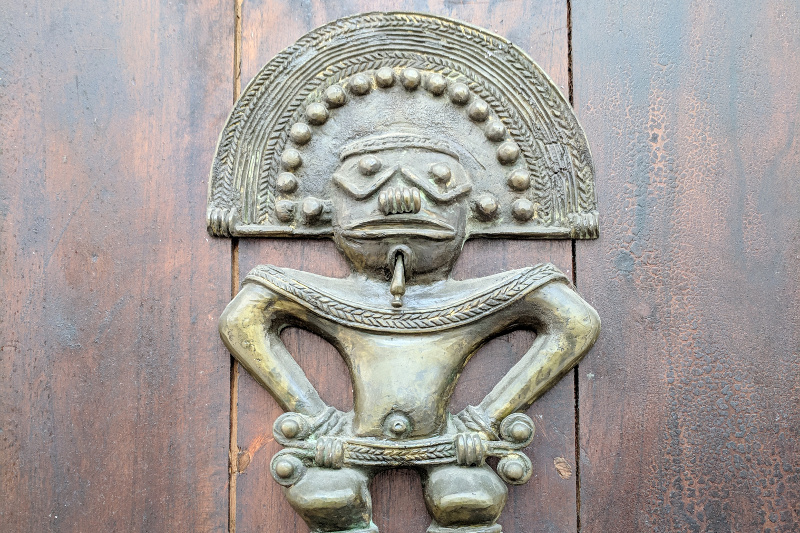One of the most disappointing things about this trip was the scant evidence in Cartagena showing the history of the peoples who inhabited the area in pre-Colombian times.
There is a temporary Gold Museum displaying stolen gold… there are a few street sellers peddling their mochilas… and a vague whisper or two in hidden corners around the city. It’s like Cartagena began with the Spanish.
But, it didn’t.
The Tairona people were one of the ancient cultures that inhabited South America during the era of the Aztec, Inca and the Maya. Unlike the others, the Tairona are the only ancient culture that still exists.
These are the people who live in the sacred mountains of Colombia, the Sierra Nevada de Santa Marta. This is their Niwin Umuke (holy land). The Tairona originally lived in the Savannahs of Colombia but were driven into the mountains when the Spanish pushed to kill all their people in the 1600s. Moving into the mountains was a blessing because it allowed the Tairona to avoid the worst of the Spanish genocide and subjection.
Traditionally, the Tairona were known for their expertise in crafting and metallurgy, especially goldsmithing. And, this is what the Spanish wanted: gold. This gold still fuels the destruction of many Tairona burial sites by grave robbers who will frequently loot them for the gold.
From what has been recovered (some is displayed in the main bank in Cartagena or in the gold museum in Bogota), people can get a glimpse at the relationship that the Tairona had (and still have) with other creatures, the mother, and the spirit world.
The Arhuaco
I found the Arhuaco people the most interesting and inspiring to listen to on this journey. They talk about co-existence, harmony and balance; this is a message that resonates with us. They are not against progress but speak out against avoiding excess and unnecessary destruction… to honour that which gave us life (the Earth). Progress is important, co-existence is important, but it must be done in a way that does not kill all life.
They fight for the Sierra Nevada to be conserved and remain as it is. However, their “protected reserve” is constantly being eaten away by the Colombian government for mining and roadworks projects.
On the streets in Cartagena, you’ll find young Arhuaco men selling traditional mochilas and coffee beans. This is one way they bring money into their community.
The Kogi
These are messengers from the Earth believed to be the descendants of the Tairona. They see themselves as the older brothers to the rest of the world; they understand that the younger brothers (non-Kogi) are able to use technology and inventions but the younger brother is no longer in touch with the Earth.
Their message is that the older and younger brothers need to live in harmony so the Earth can survive. To better understand the brother concept, watch this video.
The Kogi have successfully used technology to help with their fight to preserve our natural reserves and deforestation in Colombia (with help from companies like Google). They also use outreach programs to help the communities around them to understand how to work with nature and not destroy it.
The Wiwa and the Kankuamo
The Wiwa and the Kankuamo are two groups that have not been as closed to outsiders. The Wiwa actively encourage foreign treks into the Lost City (which is not lost at all) because this brings revenue into their villages and help outsiders understand their beliefs and the challenges they face.
We found one 5-day hike that you can do with the Wiwa; and, are already thinking about our next trip to Colombia so we can do this hike.
The Kankuamo were more elusive to us. From some people, we heard that they are fully integrated into Colombian society and are no longer visible as a minority group. From others, we heard they don’t interact with outsiders at all and have managed to avoid all contact. The truth is likely somewhere in the middle.
From reading Colombian news and the Kankuamo website, it seems the Kankuamo are deemed “integrated” because they speak Spanish and work within Legal systems to fight for the rights of the Peoples of the Sierra Nevada. This makes them communicators and mediators but doesn’t mean they are “integrated” (what does “integrated” even mean?).
As we know from being a part of the Métis community, what this does mean is it puts the Kankuamo at risk for acts of violence and derision from people who don’t understand.
